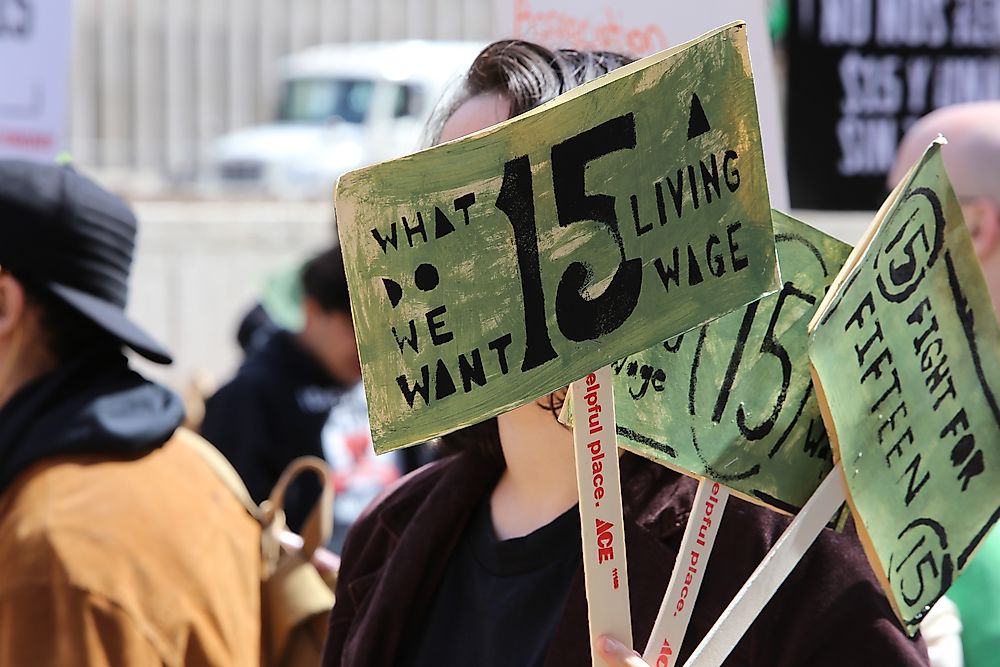States With the Lowest Minimum Wage

Minimum wage is the lowest amount that the law requires an employer to pay a worker per hour. In the United States, the federal minimum wage is $7.25 an hour. Even though the United States has set the federal law, it allows individual states and localities to pass their own wage laws. As long as this wage is set at higher than $7.25 an hour, a state can have a say in what their minimum wage is. Alabama, Louisiana, Mississippi, South Carolina, and Tennessee have no official minimum wage, so must adopt the federal minimum wage.
Purpose of a Minimum Wage
Setting a minimum wage raises earnings and reduces poverty. It ensures that firms have the responsibility to ensure that their workers earn enough for sustenance. It also protects the taxpayers from exploitation by companies who may want to get the most benefits at the cost of their employers. Not only does minimum wage protect the employee, but it also reduces the burden of the welfare payments on the federal. Determining a minimum wage causes a stimulus to the economy. Such stimulus benefits the economy and increases the sales of the businesses which in turn boost profitability.
Four factors determine the setting of a minimum wage: the needs of workers and their families, the capacity to pay, comparable wages income, and requirements for economic and social development. There is a high elasticity for low-skilled workers which mean that a small change in price causes a greater impact on its demand.
History of Minimum Wage Legislation in the US
In 1938, President Roosevelt passed the first federal minimum wage in the US, set at 25 cents per hour, an equivalent of about 4 dollars per hour in contemporary rates. It was part of the Fair Labor Standards Act (FLSA) which also covers aspects like youth employment overtime pay and record keeping. Although the US passed its first law in 1938, some individual states like Massachusetts already had their legislation in place.
US States with the Highest Minimum Wage
There are 29 states with the minimum wage set higher than the federal standard. In Oregon, Senate Bill 1532 increased the minimum wage in the Portland metro area to $12.00, the highest minimum wage of the 50 states. However, the same bill set the minimum wage in Oregon to $10.50 in rural counties and $10.75 in non-rural counties. Aside from Oregon, the states with the highest minimum wages are Washington ($11.50), California ($11.00), Massachusetts ($11.00), Arizona ($10.50), and Vermont ($10.50). The minimum wage in Oregon across the Portland metro area ($12.00), non-rural counties ($10.75), and rural counties ($10.50) places Oregon within the top 6 states for the highest minimum wage across the United States.
It is important to note that individual counties and cities have set their own minimum wage laws, some significantly higher than the state minimum wages. For example, as of October 2017, the minimum wage in Prince George's County, Maryland is set to $11.50 per hour, $1.40 higher than Maryland's state minimum wage of $10.10 per hour.
US States with the Lowest Minimum Wage
Fourteen states have their minimum wage set to the federal standard of $7.25 per hours. These are Idaho, Indiana, Iowa, Kansas, Kentucky, New Hampshire, North Carolina, North Dakota, Oklahoma, Pennsylvania, Texas, Utah, Virginia, and Wisconsin. There are two states with the minimum wage set lower than the federal minimum wage. The states of Wyoming and Georgia have set their minimum wages at $5.15 per hour. The federal wage laws have rendered the minimum wage laws in Georgia and Wyoming obsolete.
Effects of Minimum Wage
Proponents of the minimum wage believe that it has benefits such as increasing standards of living, minimizing poverty levels, boosting morale, reducing poverty, and reducing the inequalities in the allocation of wage rates. In essence, the minimum wage is set to prevent the exploitation of workers by their employers. The minimum wage helps to regulate economic vices such as the high crime rates. Studies show that an increase in minimum wage decreases the crime rates in a state. It also helps in economic growth due to the increase in wages which translates to increased spending and savings/investment. On the other hand, opponents of minimum wage say it increases unemployment and poverty. It also damages businesses since it increases the salary and wages expenses thereby heightening prices of goods and services.
Minimum Wage By State In The United States
| Rank | State | Minimum Wage |
|---|---|---|
| 1 | Mississippi | None* |
| 2 | South Carolina | None* |
| 3 | Louisiana | None* |
| 4 | Alabama | None* |
| 5 | Georgia | 5.15* |
| 6 | Wyoming | 5.15* |
| 7 | Texas | 7.25 |
| 8 | Oklahoma | 7.25 |
| 9 | Kansas | 7.25 |
| 10 | Virginia | 7.25 |
| 11 | Kentucky | 7.25 |
| 12 | Utah | 7.25 |
| 13 | Idaho | 7.25 |
| 14 | North Dakota | 7.25 |
| 15 | Wisconsin | 7.25 |
| 16 | Iowa | 7.25 |
| 17 | Indiana | 7.25 |
| 18 | Pennsylvania | 7.25 |
| 19 | New Hampshire | 7.25 |











